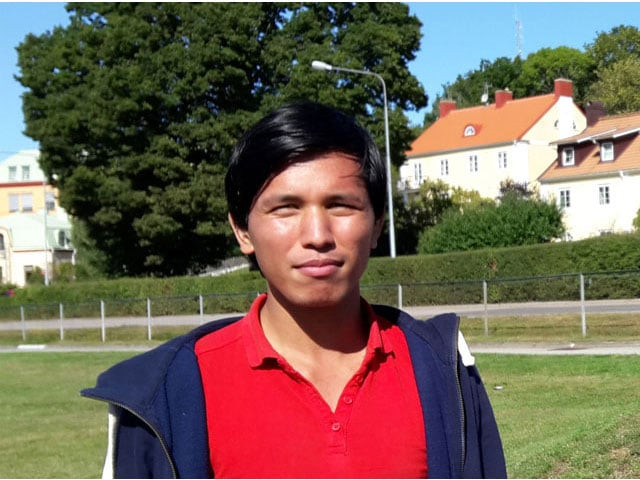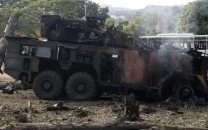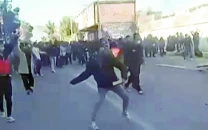Afghan boy's hope of new life in Europe ends in suicide
During nine months of stay, the authorities had not managed to carry out a single interview for his asylum application

Afghan migrant Mustafa Ansari is seen in an undated handout photograph taken in the Swedish town of Karlshamn and provided to Reuters June 3, 2016. PHOTO: REUTERS
At around 7 a.m., staff at the young asylum-seekers' centre where Ansari was staying found him dead. The sheets of his metal bunk bed were tied so tightly around the Afghan teenager's neck, an inquiry later learned, the staffer who found him had to cut the noose with a knife.
Around the soccer-mad boy's room were brightly coloured Post-It notes scribbled with Swedish words he had been learning.
An autopsy found Ansari, who had no papers but was described in the autopsy as 17, had committed suicide. During nine months in Sweden, the authorities had not managed to carry out a single interview for his asylum application.
The young Afghan was a new kind of casualty in Europe's migration crisis. While thousands have died on the journey to Europe, Ansari made it, only to become caught up in an overloaded system. His story highlights the limits on capacity even in a country like Sweden, which has one of the most open policies towards migrants and refugees. It also underlines the anxieties and risks faced by the more than 100,000 unaccompanied young asylum-seekers who have reached Europe since 2015.
Sweden has long been welcoming of refugees and is proud of its humanitarian record. It threw open its doors to all Syrians in September 2013 and has taken in more asylum-seekers per head than any other European country.
But as more than a million migrants reached Europe illegally last year, mass applications choked systems everywhere. Sweden said it couldn't cope.
Processing times for asylum-seekers in the country have nearly tripled over five years to a median of longer than nine months, from just over three months in 2011. Care-workers have lost track of more than 1,000 unaccompanied minors, a third of whom are Afghan males, since 2014.
Four-year-old Afghan boy dies on migrant boat
Last November, the country started to restrict the number of migrants it lets in. The deputy prime minister wept on TV when she announced the curbs.
"We have taken in too many for too long," said Prime Minister Stefan Lofven at the time. Sweden's migration minister said last week he did not believe any other country had given unaccompanied minors a better reception than Sweden.
When authorities struggle with asylum applications, psychiatrists say they incubate multiple problems. Applicants are often isolated. Some are already traumatised by their experiences and prone to mental illness and self-harm. Others fall into crime or - in the worst case - recruitment by militant groups.
"The longer they wait, the angrier they become," said Edgar Jones, a professor of the history of medicine and psychiatry at King's College, London.
Sweden's agency for managing asylum-seekers took on more staff and has simplified decision-making, but wait times have still increased. It says it expects them to peak later this year at 12 months.
"I have people writing to me every day, saying, 'I've been here for 12 months, 14 months, and nothing happens,'" said Mikael Ribbenvik, director of operations at the Migration Agency. The agency does not comment on individual cases.
Migration Agency records show at least 500 occasions when asylum-seekers of all ages threatened or attempted suicide between January 2014 and the end of August, a period when more than a quarter of a million people applied for asylum in Sweden. Three attempts ended in death. What motivated them is not clear - the records show some were directly related to delays in applications.
Ribbenvik conceded the records are likely an undercount: Suicidal behaviour is only noted when it affects immigration staffers' working conditions in some way. Ansari's case, for example, is not included in the data.
Asylum-seekers are generally more likely to attempt suicide than the general population, studies have shown. They suffer high rates of depression, psychosis and other mental health conditions, largely because of the trauma they have fled. In Sweden, government and other groups have estimated that around a quarter of asylum-seekers suffer from mental illnesses like depression and post-traumatic stress disorder.
Ansari had travelled alone. His autopsy report says he was suffering from depression and bipolar disorder. Friends say he desperately missed his family. He waited months for a meeting to process his claim, but the agency cancelled one meeting and messed up the venue for the other. "He used to speak about his frustration," said his fellow asylum-seeker, 18-year-old Afghan Mohsen Naghawi. "He saw himself as unlucky."
Peter Valverius, chief medical officer for psychiatry in Blekinge, the county where Ansari lived, was involved in the county's inquiry into the young man's death. He said the cancellation of Ansari's second asylum interview seemed crucial: "There is a big probability that it was the trigger."
Escape from recruitment
Ansari was the eldest child of an Afghan housewife and factory security guard who live in Shiraz province in Iran. The boy had travelled for a month through Turkey, Greece and on to Germany, said his father, Ali Yawar Ansari. He arrived in Sweden on July 24, 2015, one of more than 23,000 unaccompanied Afghan minors to reach the country that year.
Like many Afghans, Ansari was actually a double refugee. He was a member of the Hazara, a Shia community of possible Mongolian ancestry. His people have long faced persecution in Afghanistan; many fled to Iran in the 1990s after they were targeted by the Sunni Taliban.
Ansari grew up in Iran, among hundreds of thousands of Hazara refugees. Because of their Asiatic features they stand out and face harsh discrimination including jail or deportation, rights groups say.
There are no official figures, but Kasim Husseini, an official at the Swedish Committee for Afghanistan, an aid group working in Afghanistan, estimates that more than 70 percent of Afghan asylum-seekers in Sweden are Hazaras. A Hazara himself, he travelled alone when he was 15 and arrived in 2001.
Rights groups say Hazaras have recently been recruited by Iranian forces to fight in Syria. It was that risk that drove Ansari, who was working in a plastics recycling firm in Shiraz, to try Europe, his father told Reuters.
Afghan boy dons Messi's Barcelona jersey
At first, his father said, he tried to stop the boy from leaving. But when Mustafa threatened to go anyway, the family leased land they own in Afghanistan and borrowed money from cousins to raise 4,000 euros ($4,500) to pay smugglers. That's more than double the annual GDP per capita in Afghanistan in 2015, according to World Bank figures.
Countdown
Those who knew Mustafa say he was warm-hearted with an easy smile and a love for Real Madrid soccer club.
"Among my children, he was the brightest," said Ali. "He was interested in electronic gadgets and when he went to Sweden he had a plan to study mobile technology."
Like many Afghans, Ansari planned to bring over his family from Iran once he had won asylum.
In a cafe in the nearby town of Karlshamn, Ansari's Afghan and Iranian friends said they had raised their own cash on the road for their journeys. One, Amir Hassanzade, made money in Greece by allowing trainee tattooists to practise on his arm for 20 euros a time. Another said Kurdish human traffickers had forced him to work on a construction site in Turkey to pay his way.
"You have to remember that it is a very big responsibility for these boys," said Ansari's 18-year old friend, Naghawi. "Their families have sold everything and this is on their shoulders."
That sense of responsibility intensifies the moment the boys touch Swedish soil.
 The grave of Afghan migrant Mustafa Ansari is seen at the Bredakra cemetery in Ronneby, Sweden, September 10, 2016. PHOTO: REUTERS
The grave of Afghan migrant Mustafa Ansari is seen at the Bredakra cemetery in Ronneby, Sweden, September 10, 2016. PHOTO: REUTERSWhen children arrive without passports, officials typically assign them a birth date based on the age they say they are when they land. Ansari said he was 16. So for the Swedish authorities, his birthday became July 24, 1999.
At the time, it was relatively easy for unaccompanied asylum-seekers who were under 18 to bring family to Sweden to live with them.
By giving his age as 16, Ansari had started a two-year countdown to get his family in.
Welcome to Svangsta
Svangsta is a riverside community of 1,700 in southern Sweden best known for making fishing reels. It is also home to a government-run asylum-seekers' centre, a two-storey brick building where Ansari lived with 20 other boys from Afghanistan, Syria, Somalia, Eritrea, Morocco and Iran.
Ansari had a spacious room to himself near the kitchen with a double wardrobe, refrigerator, table with four chairs, and adjoining bathroom. He had stuck a Post-It note on the table saying "bord" - the Swedish word for table - and on the walls were pairs of words in Swedish and his native Dari for abstract ideas and feelings. He loved to listen to music, loudly. The boys were given money to buy food. Ansari, who liked to cook, would make chicken with rice for his friends.
In an initial health check of Ansari nothing remarkable emerged, said Santi Kullberg, administrative chief at the centre.
He was conservative, she said, and argumentative about politics and religion. He would sometimes say women should not show so much skin and did not like shaking hands with female staff. He would say it was forbidden and instead greet them by putting a hand to his chest.
According to the county inquiry after his death, he also had difficulty sleeping. He would ask staff at the centre to sing him lullabies.
The centre's internal documents show staff noted Ansari's "melancholy" but did not see it as serious. Staff gave him "personal time" to talk three times a week. Ansari often used the time to practise Swedish or discuss social issues, Kullberg said. He was interested in why Swedes pay high taxes and where the money goes.
The boys went to school in Karlshamn, a half-hour bus ride away. New arrivals join a programme of intensive Swedish on the ground floor, separated from Swedes on the first floor. Ansari took swimming lessons and went to the mosque in town.
Young asylum-seekers in Sweden are housed by the government and allocated a guardian to act in the legal role of parent, assisting them with the process and taking care of their finances until they turn 18 or are granted residency. Legal guardians are paid around 2,000 Swedish crowns ($236) a month per child.
Ansari's guardian was 27-year-old Mohammed Yassin, a Somali. He came to Sweden in 2008 and now works as an interpreter from Somali and French to Swedish, sometimes for the Migration Agency. He had one other child on his books. He and Ansari spoke in Swedish.
In October, just over two months into his stay when more than 70,000 asylum-seekers had arrived in a few months, Ansari was due to meet the Migration Agency to start his application. But Yassin said he received a letter from the agency saying it had to postpone the meeting. It did not give a new date.
The political mood around refugees was souring. There were arson attacks on asylum-seeker centres.
Darkening days
By autumn last year, anxiety and isolation were growing for many people, incident reports by the Migration Agency reveal. In one case last October, officials had decided to deport an unidentified asylum-seeker and family. After they informed the person, the individual plunged a knife into their own stomach.
A migration official pulled the knife from the applicant's abdomen, threw it aside, then laid the person down and "kept pressure on the wound," the report said. It is unclear what became of the individual or the family. The Agency's Ribbenvik told Reuters he is concerned about such incidents, and is working to reduce waiting times.
The next month, Sweden started to toughen up on asylum-seekers, introducing restrictions on the right of under-18s to bring over family members. Ansari remained under the old rules, so still had the option of reunification - assuming he was granted asylum.
"He was counting the days to get his residency permit," said Hassanzade.
As winter approached and the days darkened, extremist attackers in Paris were found to have entered Europe with refugees travelling through Greece. This was a provincial, conservative part of Sweden. Some of Ansari's friends said they feared the Swedish authorities might be delaying their applications as a tactic to make it easier to deport them.
"Code Red"
As spring neared, according to the migrant centre staffer Kullberg, Ansari started to adopt European ways. He was accepting handshakes, even hugs, from female staff.
But he had yet to meet anyone from the Migration Agency.
He began to spend hours in his room. His smile disappeared, he stopped going to school and he lost weight, his friends said.
Maria Sundvall, a Stockholm-based psychiatrist who studies mental health issues among migrants, said she knew of other unaccompanied young people who had yet to have a first interview after eight months in Sweden. Some had not been able to start learning Swedish for six months after their arrival.
"When you are not even allowed to present your case, it can certainly be expected to affect your mental health," Sundvall said.
On March 9, after a night and morning of what the county inquiry called "overwrought behaviour and having been agitated," Ansari was taken to an emergency psychiatric ward in a town about an hour away. No suicidal thoughts or plans emerged in the discussion, said the inquiry, which was sent to Sweden's Health and Social Care Inspectorate.
Asylum-seekers under 18 are entitled by law to the same healthcare as Swedes. But in rural Sweden, few health experts have experience of issues like post-traumatic stress disorder, and mental healthcare is further complicated by a shortage of competent interpreters. "It makes the entire system much more shaky, since one has to be able to trust the interpreter," said Valverius, the chief regional psychiatrist.
Ansari was put on medication; the documentation does not say what. At a follow-up meeting with a doctor in Karlshamn on March 11, he was diagnosed as experiencing a "manic episode" - one of the symptoms of bipolar disorder.
It was around then, according to centre and county documents, that Ansari's doctors changed his care classification to "code red," meaning he was at risk of suicide, violent or threatening behaviour, or had been subjected to threats or violence.
Afghan teen inventor with big dreams on the migrant trail
His father said the only thing his family knew from Mustafa was that he had a cold and a headache. "He was talking with his mother daily and was complaining about the medications he was taking for his headache," said Ali. "It used to make him dizzy, sleepy and he was not feeling good with it." His father said migrant centre personnel forced him to take the medicine, which Kullberg said was not true.
A wrong address
Finally, on the morning of April 6, Ansari got a meeting with the Migration Agency. He and his guardian travelled to the town of Vaxjo.
When they arrived, they discovered that the agency had mistakenly sent Ansari's legal counsel to Malmo, more than two hours' drive away.
The Migration Agency said there had been a misunderstanding. It said it called a new meeting for May 3.
The next day, Ansari made an emergency visit to the young people's psychiatric ward in Karlshamn. He was deemed "dejected and discouraged," but no suicidal thoughts or plans were apparent, the inquiry found.
On April 7, Yassin, received an SMS from Ansari, saying, "I am not well," repeated several times.
A few days later, the boys invited him to join them to watch a Champions League soccer match on TV at the centre. As they watched, the boys said, staff called him away for his medication. Kullberg said that as far as she could remember, he went to his room himself and was visited there by staff offering him the medicine.
That was the night he killed himself. The staff waited until the next afternoon to tell the other residents that Ansari was dead.
Ansari's father said the first the family knew was when an Afghan activist living in Sweden posted a picture of Mustafa on Facebook. It said a 17-year-old asylum-seeker had died in a refugee centre in Karlshamn. One of the father's cousins phoned one of Mustafa's friends in Sweden and confirmed his death.
The family still owes around 1,750 euros to their cousins for his journey. They are paying in instalments.
In Karlshamn, Ansari's grave lies next to two others with Afghan and Arabic names, at a distance from the rest of the cemetery. His name is on a card slotted into a plastic envelope glued onto the makeshift headstone.
In its inquiry, Blekinge county found no signs of wrongdoing in the care for him. Asked about the report, Valerius, the psychiatrist, said there was not much more the medics and centre staff could have done to support the mentally unstable youth through a difficult time. "In my opinion," he said, "one has actually done slightly more than what duty calls for."



















COMMENTS
Comments are moderated and generally will be posted if they are on-topic and not abusive.
For more information, please see our Comments FAQ